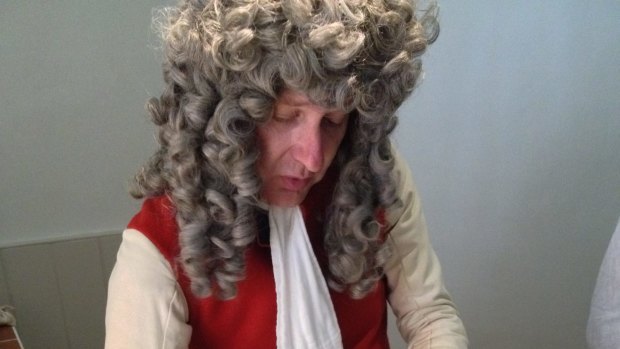This was published 8 years ago
Hampton Court Palace: The King's chocolate
Cacao was big business in 17th century Britain. Tim Richards breaks off to tour Hampton Court Palace where the royal chocolate kitchens have recently reopened to visitors.
By Tim Richards

Choc’n’roll: 'King George’s chocolatier' shows how hot chocolate was made in the 17th century.Credit: Tim Richards
"A chocolate house is like a nightclub. You've got to be on the list. You want to meet the people at it because they're society's high fliers. It's music, dancing girls, and chocolate."
Food historian Marc Meltonville is giving me a whole new perspective on the humble cup of hot chocolate, as we stand chatting in a corridor at Hampton Court Palace. In the 17th century, he says, it was one of the "big three" hot beverages introduced to Britain, and each had a distinctive place in society.
"A coffee house was a bit like a pub, and tea houses were open to all," he says. "You could take your wife to a tea house, but you couldn't take your wife to a coffee house. You could take your wife to a chocolate house, but why wouldn't you take your mistress?"
Chocolate, being derived from the slow-growing cacao tree and restricted to equatorial climates, was expensive and a badge of status.
The royal residents of this London palace had a set of kitchens dedicated to preparing the beverage, but over the centuries it fell into disuse and its location was lost.
However, the recent discovery of an old inventory map revealed all, and in February 2014 the royal chocolate kitchens reopened to visitors with a display of chocolate-making items.
They also host regular chocolate-making demonstrations, for which Meltonville dons the white cap and apron of an 18th century kitchen hand. He's accompanied by a stand-in for King George I's personal chocolatier, Thomas Tosier, who sports a spectacular wig.
Together, they demonstrate hot chocolate production in King George's day. On a granite bench, Meltonville methodically rolls the solid chocolate derived from the cacao beans.
Nearby is a wooden bench bearing spices which were added to the drink in that era, including cardamom, aniseed, vanilla and all-spice. I'm surprised to see chilli as well, but Meltonville assures me it was used for a time as early chocolatiers took cues from the drink's South American homeland.
Not that Europeans instantly cottoned on to chocolate's potential, he says, holding out a handful of cacao beans. "At first the Spanish were overturning canoes full of these, looking for gold."
As they work, the two give a running commentary and answer questions from onlookers crowding into the small room. It's great to see how engaged my fellow visitors are with the demonstration. It could be an after-effect of all those food-related reality shows on TV, but maybe it's just a general love of chocolate at work.
As the crowd clears a little, we're graced by a surprise visit from King George I himself, impersonated by an actor who strolls through the palace in his guise.
The German-accented monarch asks questions about the process, remarking how extraordinary it is. He then insists an accompanying costumed courtier taste a cacao nib, before asking in a concerned manner about his health.
At the nearby Fountain Court Cafe within the palace, I'm able to order the drink prepared to a historic recipe. This week it's a 1662 concoction, which has a hint of chilli beneath the rich dark chocolate flavour.
It's delicious. The king may be dead, but long live his chocolate.
Entry to the chocolate kitchens is included with a ticket to Hampton Court Palace; adult ticket £18.20, book via hrp.org.uk/HamptonCourtPalace.
Tim Richards travelled at his own expense. His fantasy novel Mind the Gap features London, and is available as an ebook published by Harper Collins.
See also: The world's 10 best places for chocolate lovers
See also: The home of Terry's Chocolate Orange leads UK's choc revival
Sign up for the Traveller Deals newsletter
Get exclusive travel deals delivered straight to your inbox. Sign up now.